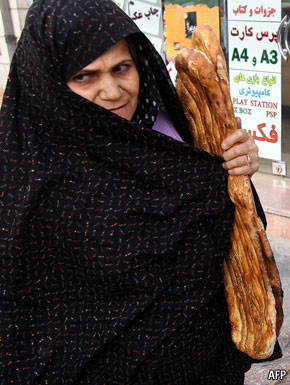
GOOD news from Iran is rare, and the IMF is seldom a font of happy tidings about anything. So when a mission from the Fund cheered the Islamic Republic’s economy earlier this month, heaping praise on the policies of its ruthless government, eyebrows spiked upwards as in a comic scene in a Persian miniature. The shock was even sharper given that the IMF, whose biggest shareholder happens to be the Great Satan, America, is a pillar of global capitalism, a system that Iran’s maverick president, Mahmoud Ahmadinejad, gleefully lambasts as evil.
Yet the IMF’s upbeat pronouncement, in a brief press release (a fuller report is forthcoming) following annual consultations in Tehran, has some justification. This is not because Iran’s economy is performing brilliantly. Whereas other big oil exporters have boomed on the back of high prices, Iran has grown sluggishly, nudging upwards only last year to 3.5%. That is not enough to dent a rising unemployment rate, which is now close to 15%.
The reason for the praise is Iran’s exemplary execution of a task dear to the IMF’s heart: structural reform. The Islamic Republic describes things differently. Speaking on the occasion of Nowruz, the Iranian new year in March, the supreme leader, Ayatollah Ali Khamenei, declared this to be the “year of economic jihad”. Whatever its name, the sweeping reform of a ruinous, three-decade-old system of state subsidies that Iran began last December seems to be radically reshaping the country’s economy for the better.
Not only has it relieved the government of a huge financial burden. It has slashed local energy demand, reducing chronic pollution and leaving more oil for export. It has dramatically raised disposable incomes for the poorest without placing extra burdens on the rich, spreading social equity while boosting consumption and bolstering the banking system. In future, Iran’s subsidy reform may even be seen as a model for top-down social change, not unlike successful schemes pioneered by Mexico and Brazil. But so far Iran’s scheme carries no conditions.
Until December, economists estimated the annual cost of subsidies on food, fuel and electricity at $60 billion-100 billion, a quarter of Iran’s GDP and equal to or greater than the value of annual energy exports. Most of this burden was carried as an implicit subsidy to domestic energy consumers, with the price of diesel fuel, for example, set at the equivalent of two American cents a litre, and petrol selling for less than bottled water. The predictable results were soaring energy consumption, waste, smuggling, pollution, market distortion and inexorably rising bills for the state.
Iranian governments have long grappled with this problem. Mr Ahmadinejad’s liberal-leaning predecessor, Muhammad Khatami, was stymied by a squeamish, conservative parliament. Mehdi Karoubi, a presidential candidate in 2005 and 2009, suggested tying cash handouts to reduced subsidies. Rivals dismissed this as an electoral ploy; Mr Karoubi, a leader of the opposition Green Movement, has since been hounded out of politics. Ironically, it may have been international sanctions, intended to punish Iran for its suspect nuclear programme, that at last persuaded its opponents of the need to scrap subsidies. Lacking the refining capacity to meet domestic demand, Iran found itself vulnerable to a sudden cut-off in petrol imports.
This long debate helped to prepare the public and let the government plan carefully. Accepting the need to compensate consumers for raising prices closer to world levels, Mr Ahmadinejad at first proposed a monthly cash transfer aimed at poor families. When defining the poor proved tricky, this was dropped in favour of blanket transfers to any family that applied for them. Some 19m families, 90% of Iran’s population, have done so, setting up bank accounts to receive monthly payments based on numbers of family members. The government then set up a fund to administer receipts from the higher-priced goods, demarcating 50% to go towards families, 30% to help businesses affected by price rises and 20% to meet the state’s own added costs.
The government cleverly doled out two months’ worth of family cash transfers, amounting to some $90 per person, before unleashing its shock. When the first tranche of price rises hit, quadrupling the cost of some kinds of bread and shooting diesel prices up by 2,000%, among other things, there was barely a peep from the public. Iranians have rapidly got used both to paying a lot more for some things and to having more money to spend as they wish. A family of five now pockets monthly sums close to Iran’s minimum wage, enough to pull a big proportion of the 10% of Iranians who live on less than $2 a day above that bar. Yet tight controls on the money supply have kept inflationary pressure lower than feared. By some counts it has already fallen from an annualised 20% in March to 14% in May. With government finances now in better shape, that may drop still further, and quickly.
